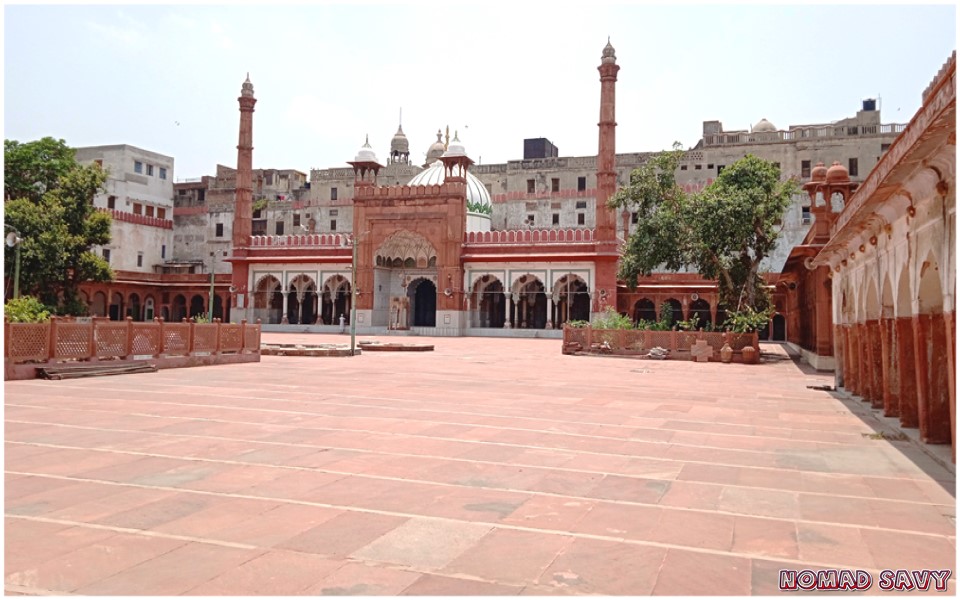Fatehpuri Masjid, Delhi
Fatehpuri Masjid is a 17th-century mosque located at the western end of the oldest street of Delhi, Chandni Chowk. It is opposite the Red Fort on the opposite end of Chandni Chowk. In the year 1650, Fatehpuri Masjid was built by one of the Shah Jahan's wife - Fatehpuri Begum. The mosque is built with red sandstone on a large scale and is surmounted by a single dome. This mosque is a beautiful specimen of the magnificence of Mughal architecture and stands as a silent spectator, witnessing all historical events right from the Mughal and British periods till date. Flanked by towering minarets, the mosque has a traditional design with the prayer hall having seven-arched openings. Among the seven arches, the central arch is the highest. The mosque is thronged by devotees and tourists alike owing to its heritage and historical significance. The most popular festivals celebrated at the place are Id-ul-Fitr and Id-ul-Azha when the edifice is beautifully decorated and is a sight to behold..

History of Fatehpuri Masjid
Built in 1650, this mosque is still a haven of peace for worshippers and visitors alike. Not only does it stand to portray the history of Mughal rule, but it also holds within its walls the symbols of the British rule as well as the lives of the common people over time.
The Buland Darwaza, which is the entrance of the mosque, was built to depict allegiance and praise Akbar’s victory in Gujarat. The white marble tomb which immediately captures attention is that of Shaikh Salim Chisti and towards the right side. There are the graves of his family members, thus establishing a lineage of Islamic knowledge.
The mosque had been used by the Indian Sepoys or rebels in their revolt of 1857, thus making it a symbol of rebellion against the East India Company. But after the first war, it became a property of the British administration and it was put up for sale. One man, Lala Chunnamal, a wealthy merchant from Delhi, purchased it for a mere 29,000 rupees, a considerable amount for that time.
In 1873, the British government tried to buy the mosque back but Chunnamal refused and it was only in 1877 that it was bought back from his son for an increased amount, along with four villages and thus reestablished in the name of the Muslim population of the city. Prayers resumed in the masjid and continue to this day.
Architecture of Fatehpuri Masjid
One enters the mosque through Buland Darwaza, which means Victory Gate and with a height of 54 metres, it establishes the magnificence of the place. Once inside the compound, there are three intriguing spots. First is the tomb of the great Sufi Saint, Shaikh Salim Chisti. Constructed out of white marble, there are colourful prayer threads tied on the jaalis by women with the desire of children. Secondly, there is an entrance to a barred tunnel which leads to the Agra Fort in Uttar Pradesh. And once in the courtyard, you will find the graves of around twenty scholars of Islam.
Talking about the main mosque itself, it is constructed on an elevated platform and is framed by two alluring minarets looking over it. The central opening in the prayer hall has the highest dome and is adorned with white marble. It is believed that fountains and a central tank used to exist here at some point but they were reduced to ruins in the 1857 British Invasion of the mosque.
Festivals at Fatehpuri Masjid
- Id-ul-Fitr is the grandest festival of the Muslims celebrated with a whole lot of zeal and enthusiasm. Also known as the ‘Festival of breaking the fast’, the festival is celebrated after a month of fasting when the new moon appears. Thousands of devotees gather at the mosque on the day of Id mostly wearing white kurta-pajamas; a grand prayer is held in the morning post which people hug each other and greetings are exchanged.
- Id-ul-Azha is the second most important festival celebrated at the mosque. The festival is also known as the ‘Festival of Sacrifice’. A grand prayer meet is held at the mosque which ends with a special ‘Dua’ for the peace and prosperity of the believers. People exchange greetings and donate food.
How To Reach Fatehpuri Masjid
The nearest metro station to Fatehpuri Masjid is Chandni Chowk situated on the red line. After getting down, you will have to take a sharing auto or rickshaw to reach your destination. Alternatively, you can travel in one of the state-run buses which regularly ply on this route.





No comments: